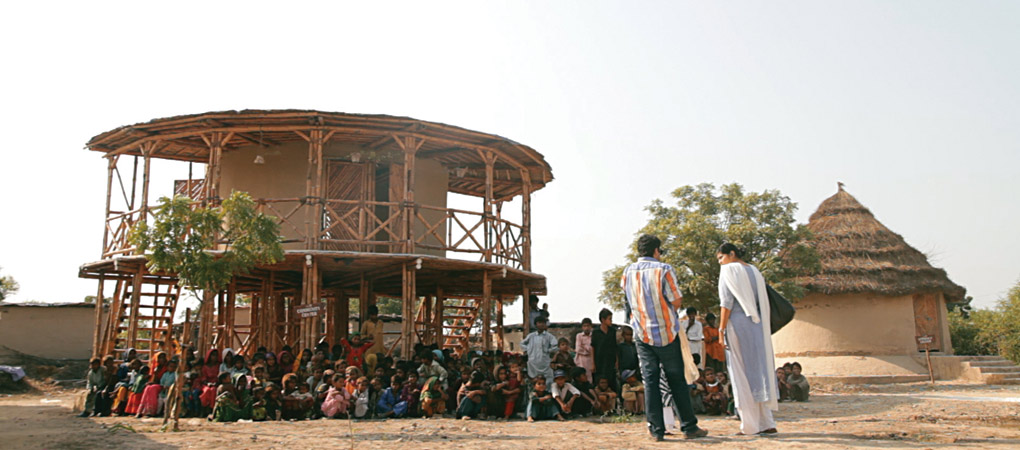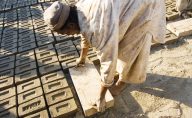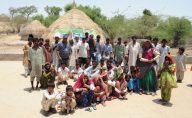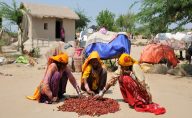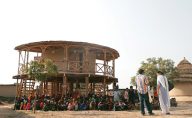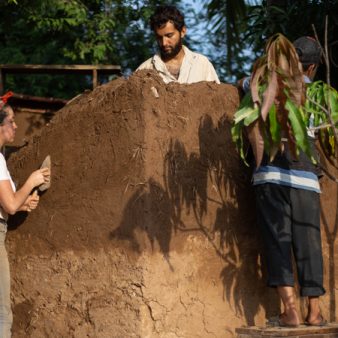848,000 houses were destroyed and 9.7 million people affected by severe floods in western Pakistan in 2011. This project developed and provided support to build over 20,000 flood resistant houses by the most vulnerable families based on local and traditional building designs. The houses were built using local labour and construction skills. Water resistant and lighter weight materials, such as lime and bamboo were introduced, creating huge savings in cost and embodied carbon over standard reconstruction approaches.
Project Description
What are its aims and objectives?
The aim of the project was to quickly provide low-cost safe housing to some of the most vulnerable families affected by the floods. The project did not take the approach of direct post disaster reconstruction; instead it facilitated a mass community self-build programme. Most of the communities affected were remote, had few resources and families frequently had a poor understanding of the structural vulnerabilities of buildings.
The project achieved its aims by supplying disaster-resistant materials and facilitating wide-scale training of communities to rebuild buildings themselves using these materials.Within each district, local project partners worked in collaboration with government authorities to identify the most affected villages. Committees of local people who knew the families were formed. These committees selected the neediest families, using previously established criteria. Priority was given to families whose homes had been completely destroyed. The highest priority was given to those families who also had disabled or elderly family members, had particularly low incomes or where the family size was large. The project worked with the communities to provide training on effective building techniques. This approach helped people to build 23,387 houses at an average cost of US $300 per house.
What context does it operate in?
Floods affect large parts of Pakistan. The 2011 flood was particularly severe and 848,000 houses were destroyed or damaged and 9.7 million people were affected by severe flooding in Southern Sindh and Eastern Balochistan. These regions are amongst the poorest in Pakistan and many residents were very vulnerable, even before the disaster. Houses collapsed under the weight of waterlogged roofs and foundations were compromised by the flood waters. Many of the affected areas had also been hit by floods in 2010 and families reconstructing homes after those floods lost everything twice. This project has focused on helping rural communities which have suffered disproportionally from the extensive flooding.
The Heritage Foundation has been involved in post-disaster reconstruction since the 2005 Kashmir earthquake, where the organisation recycled materials such as stone, mud and wood from collapsed houses, adding lime and traditional cross-bracing (dhajji) to create stronger buildings. Another local material, bamboo, was subsequently tested and proven in housing displaced populations in the Mardan region. The use of these materials was then further developed during post-flood reconstruction in the Swat region in 2010, using multiple bamboo joists and cross-bracing to carry heavy roofs, withstanding subsequent flooding and several feet of snow.
This experience was then taken further in early 2011, after the 2010 floods in Upper Sindh, creating bamboo buildings on stilts, thus proving the feasibility of building two-storey structures of bamboo that have withstood several floods since; this included housing over 400 households. All this experience fed into the current project, implemented after the 2011 floods in Lower Sindh.
What are its key features?
Various aspects make this project unique. Most important is the experience gained by all the project partners including the UK Government’s Department for International Development (DFID) and International Organisation for Migration (IOM) in previous disasters and shared in this project. This experience, in terms of suitable building materials and building techniques, was then further piloted, tested and proven in the programme area, before being scaled up into this project. The project adopted materials that had proved to be durable and flood resistant in post disaster reconstruction in other parts of the world. This included bamboo, which was used in place of timber and steel. Bamboo was cheap, flexible and strong and experience had shown it to be more resilient than timber and steel to floods. Hydraulic lime is a form of mortar that is much more water resistant than other forms of mortar. It had not previously been commonly used in Pakistan but can be made easily from locally available materials. It was used instead of fired bricks and cement.
These materials were then adapted into traditional building designs and techniques used in the areas affected. A significant advantage of the use of these materials were the carbon savings. By avoiding cement and fired bricks wherever possible, the wider project has saved approximately 365,000 tonnes of carbon dioxide. Implementation was then supported by large-scale training of the communities, raising awareness around disaster risks and the vulnerabilities of their traditional ways of building. It then provided knowledge and training in using bamboo and lime materials to create safer buildings.
How is it funded?
Overall funding of £30m over three years has been provided by DFID based on detailed proposals submitted by the implementing partners, including International Organisation for Migration (IOM), which then worked with the national organisations, such as Heritage Foundation. The costs of technical consultants, training and community level training and support are included in the overall budget. The capital costs were US$300 per One Room Shelter (ORS) plus an estimated US$214 per house as the cost of overheads, transport, advisors, equipment, consultants and researchers. DFID has played a key role in the project by maintaining its funding for reconstruction after all major floods.
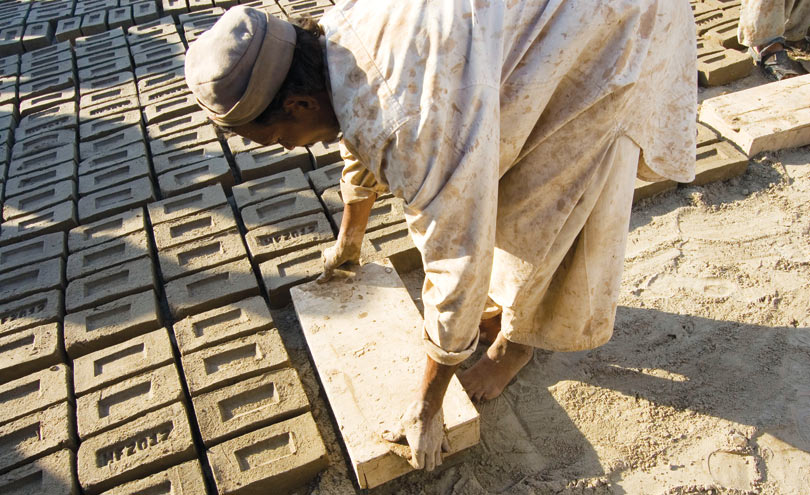
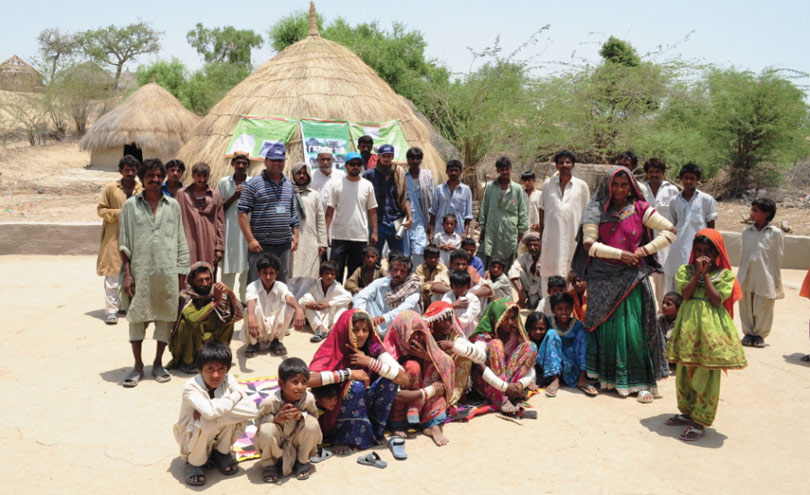

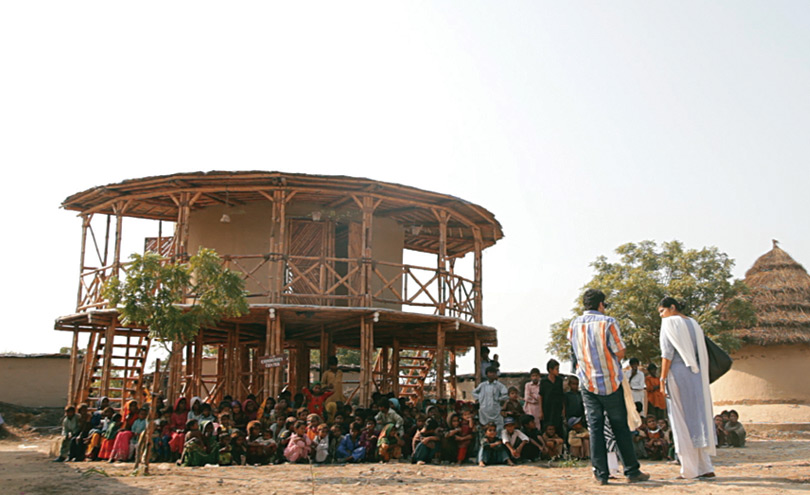
What impact has it had?
23,387 shelters had been completed, by Heritage Foundation by the end of the programme in 2012. The wider DFID programme, of which this was a part, implemented by various other partners, has benefitted 100,000 families in Sindh and Balochistan. The project has also enhanced the livelihoods and promoted the use of local materials. The techniques have reduced the carbon emissions and demonstrated an approach to deliver flood resistant reconstruction at an affordable price. Evaluation studies are underway to further gather the evidence of the project impact.
Why is it innovative?
- Low environmental footprint due to the use of local, mainly low or zero-energy materials.
- Re-introduction of lime to improve earth construction.
- Improvements to vernacular construction that are innovative in each specific location.
- Introduction of barefoot building entrepreneurs.
- Greater involvement of women in construction, income generation and community based disaster risk management (CBDRM).
What is the environmental impact?
According to the estimates made by DFID’s advisor, by avoiding the use of cement and fired bricks this project has saved approximately 365,000 tonnes of CO2, which is equivalent to three days’ emissions from the city of London or 170,000 inter-continental return flights. The project has used local, light-weight materials. The use of bamboo instead of wood reduces the environmental impact on forests. The project does introduce improved stoves, which should be more fuel efficient.
Is it financially sustainable?
The project started by making use of the Floods Relief Fund made available by DFID. By giving beneficiaries the skills to self-build with improved vernacular technologies, no further funding is required to maintain the project, although there are still thousands of families requiring help. The decentralised procurement process also contributes to local income generation. With the help of International Labour Organisation (ILO), the Foundation has also been able to initiate a programme of village barefoot entrepreneurs, who are now marketing the project’s shelters or parts thereof, including eco-toilets, stoves and other innovations. Local tribes, known as Odhs, who are traditionally employed in construction, have also found work locally. In addition, the programme and its precursors have been piloting women-focused Community-based Disaster Risk Management Centres, which have promoted alternative income generating activities.
What is the social impact?
The project worked with the local communities and government departments.
The village committees were established to deal with the selection of beneficiaries, the management of the funding at village level and through participation in training. The project placed great emphasis on reaching all households with awareness raising regarding disaster risks and training to improve on vernacular building. As the shelters were relatively small, the project foresaw they would be extended at some stage in the future and aimed to give beneficiaries sufficient skills to do so on their own. The project has changed the role of women, enabling more women to be involved in construction and various alternative forms of income generation. Women are also now beginning to take a lead role in the Community-based Disaster Risk Management Centres.
Barriers
- Though many of the improved vernacular technologies have proven their DRR in practice, funding has been lacking to actually test them structurally.
- Households had to divide their time between construction and agriculture, affecting quality and donor deadlines. Quality was also affected by not all households valuing some of the support staff’s recommendations. Some further work is needed to improve the quality and reach of technical support. After reconstructed houses had proven their value during the 2012 rains, motivation to build better increased considerably.
- Many households have been unable to extend their ORS due to extreme poverty and lack of access to micro-credits.
- Lack of funding to support trained builders to become village entrepreneurs or provide technical support.
- The programme was unable to initiate local bamboo plantations, to ensure sustainable harvesting in future.
- Convincing a large number of organisations quickly of the efficacy of the project methodology was difficult, but the use of volunteers in surveys and piloting of solutions enabled the programme to rapidly provide useful information and proven options. The method was soon adopted as a key component of the “Pakistan Initial Floods Response Plan” and in grant applications to donors and thus a relatively small initiative became influential.
Lessons Learned
- It is possible to improve vernacular technologies using mainly simple local means to become much more disaster-resistant, in many different locations and to transfer and adapt these experiences between locations.
- It is possible to help disaster victims rebuild or retrofit damaged houses with relatively limited cash inputs, of just over US$500 per household, and, based on continued research by the Foundation, this can be further reduced.
- Adequate training of each participating household is key to successful construction and its sustainability.
Evaluation
IOM monitored beneficiary selection, as explained above, as well as the proper use of cash for shelter by randomly scrutinising 5 per cent of beneficiaries. In doing so, it also ensured that monitoring would involve a visit to each village.
Transfer
Following the success of this programme in Lower Sindh, the methodology was replicated in Upper Sindh, with additions based on local technologies. Currently, 11,557 ORS are under construction there and a further 3,000 under preparation.
A survey in various programme villages revealed that community members who did not benefit from the project replicated the module with their own resources, attracted by its low cost and ease of construction, sometimes with the advice of people trained by the programme.
The Foundation has conducted training for several other agencies and communities, e.g. those affected by the Awaran earthquake of 2013 in Balochistan. And following some research, HF built several prototypes there, using earth and bamboo, with Swiss Aid. A local organisation, trained by HF will build several thousand shelters there, funded by DFID. HF is currently also being considered to provide assistance with rehousing a million people displaced from North Waziristan.

